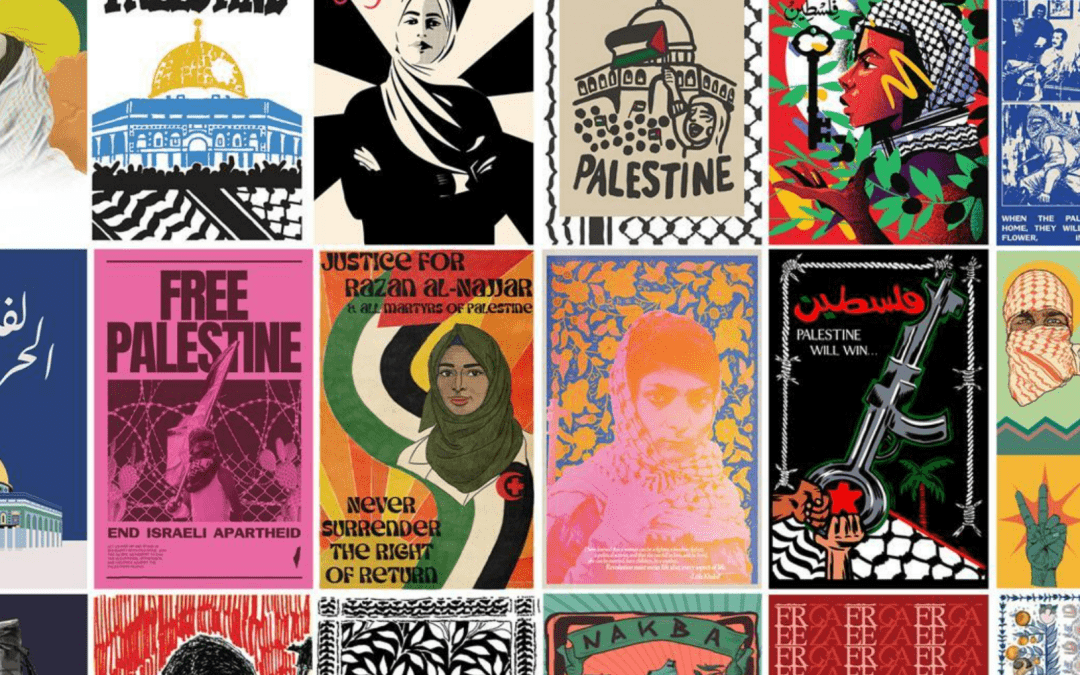By Maria Chirvanian | Staff Writer
In a world where cruelty is normalized, innocent people are being killed every day, and terrorist states are backed by the biggest hegemons1, supporters of the State of Palestine from all over the globe have been getting creative. Activist artists have been using their art to voice one of the biggest, if not the biggest, issues faced in the world today: the Palestinian genocide. Since October 7th of last year, thousands and thousands of civilians have been and are still being murdered in the worst ways possible on a daily basis, and as if this isn’t enough, the unfairness of the situation lies even more in the support Israel is receiving for all its crimes. So, for that reason, rational empathetic people have not only been speaking up about the genocide on their various social media platforms and donating funds through different channels, but a good portion of them have also been creating art that showcases the suffering of Palestinian civilians, such as portraits of martyrs (especially the young ones), or the use of the watermelon as a reference to Palestine. In the following article, we will be talking about these artists, their views, and how their art supports the Palestinian cause.
The Symbolism of Watermelon
One might wonder, why are we collectively using watermelon in art about Palestine and our daily activist post? How did this trend start? These are questions we will explore in the following.
After thorough research, I have found many cases in which artists and people have used watermelon to represent Palestine, and I have narrowed it down to two main reasons that are not mutually exclusive:
- Showcasing solidarity with the Palestinian people.
- Working around censorship.
As we all know, big brands and platforms, especially the American ones, are funding, or at least supporting, the IOF (Israel Occupation Forces) – the IOF acronym will be used instead of the IDF (Israel Defense Forces) acronym for a more accurate description of the situation. As such, platforms with billions of users, mainly Instagram, have been censoring posts about the ongoing genocide in Gaza. It follows that activists who still want to voice their unwavering support for the Palestinian cause and successfully reach a wide audience have felt the need to substitute the Palestinian flag with a watermelon because the fruit’s colors match the Palestinian flag (red, black, white, and green) (Al-Waheidi, ElBardicy, Martin, 2024).
The watermelon symbol first appeared in the 1980s, in renowned Palestinian artist Sliman Mansour’s gallery, where an Israeli soldier confiscated art containing the Palestinian flag and explained that the same fate would be met with any piece containing its colors, saying “Even if you painted a watermelon, we will confiscate it.” This is how the idea came to the artist and has been widely used since then.
Artists and Activism
When we say Palestine, we say activism. And when we say activism, we inevitably say art. One of the most popular artists who has been voicing his unconditional support to his nation is previously mentioned: Sliman Mansour. Mansour is not unfamiliar with the situation, and he is certainly not new to the scene; he has been painting for Palestine for decades, showcasing the country’s beauty and traditions. However, after the above-mentioned Watermelon-incident, he decided to turn some of his work political and denounce what had been happening for so long, using materials like mud and henna to boycott Israeli supplies after the first “Intifada2 ” of 1987 – 1993. Some of his artwork include a Woman Carrying Jerusalem (1997) and Rituals Under Occupation (1989).
Sliman Mansour might be one of the most influential artists in this area, but he is certainly not the only one. While it is true that Palestinian artists have been very loud, other artists have also shown their solidarity with the Palestinian case, risking criticism, harassment, or even losing their jobs. One example is Lebanese artist Ayman Baalbaki whose two artworks about Palestine (first: Al-Moultham – “الملثم”, meaning the veiled one, 2012; second: Thaeroun – “ثائرون”, meaning rebels) got removed from auction company Christie’s on November 9, only days before their scheduled sales.
Although many artists have accurately depicted the tremendous current situation in Gaza, the lengths of their dedication do not stop here. In fact, a lot have been donating pieces of their artwork to be able to raise emergency relief funds for this case, such as Jordanian artist Shereen Audi (creator of With Love to Palestine, 2023, representing hope) who has donated a print of this piece to Gallery Bawa in Kuwait. The gallery was holding an emergency relief sale and hit its goal of $10,000 in only five days, which pushed it to extend the sale further with new pieces.
The beginning of the Israeli occupation marked the beginning of an era of activism which deeply intensified when the October 7th, 2023 Palestinian genocide started. It has brought artists from all over the world together in unison with compassion, hope, and an incentive to make a change, mostly by showcasing the struggles of Palestinian people throughout the years, but also through donations of their dedicated artwork for this cause.
Pablo Picasso once said, “Painting is not made to decorate apartments. It’s an offensive and defensive weapon.” Consequently, artists cannot but be political beings, denouncing the world’s cruelty and moving the unmovable hearts. “Art should comfort the disturbed and disturb the comfortable,” said Cesar A. Cruz. Art is the most peaceful way to fight our most atrocious battles; let us keep fighting for Palestine.
1 The term “hegemons” refers to the world’s leading powers and biggest units, such as the United States, for example.
2 “Intifada” is an Arabic word translated as “uprising”. In this context, it refers to a civil uprising of the Palestinian people against Israeli oppression.
References
https://artsandculture.google.com/story/4-ways-culture-can-bring-you-comfort/zAWhmk2WD5hOww?hl=en
https://www.npr.org/2024/01/08/1222718339/why-watermelons-are-symbol-of-palestinian-solidarity#:~:text=In%20response%20to%20the%20ongoing,colors%20match%20the%20Palestinian%20flag.
https://www.thenationalnews.com/arts-culture/art-design/2023/10/30/arab-artists-supporting-palestine-with-bold-new-works/
https://today.lorientlejour.com/article/1358301/artists-supporting-palestine-risk-it-all.html
https://zawyeh.net/artist.html?sliman-mansour#:~:text=During%20the%20first%20Intifada%20against,and%20henna%20in%20his%20work.
https://remix.aljazeera.com/aje/PalestineRemix/intifada.html#:~:text=Intifada%20is%20an%20Arabic%20word,two%20vans%20carrying%20Palestinian%20workers.
https://www.palestineposterproject.org/posters/prints-palestine-audi

